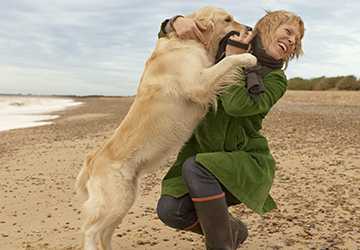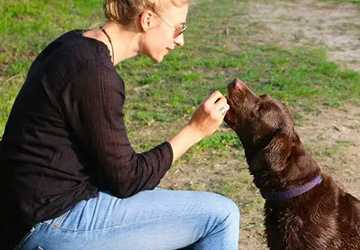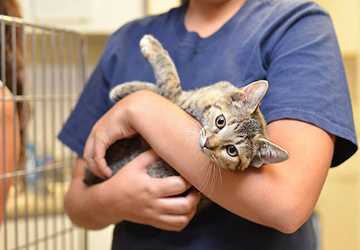How to Stop Your Dog from Jumping on People
Barking, biting, and jumping on people are some of the issues that most dog owners experience. Although it may look like an ordinary act of communication and showing concern, it can be very irritating and, at times, even fatal.
Imagine having friends over to your house; your thrilled dog is all over them, and in trying to show how happy it is, it gives your guests muddy paws to boot or knocks them off balance.

Such behaviour can be deemed rather dangerous if your guests are older adults, children, or people with limited mobility. A jumping dog is likely to smudge the person, leading to scratches of different sorts; this is even worse if the dog is significant or if the person leading it is aged or frail.
In this blog post, we'll explore the different methods and training that can be used to tackle and prevent this unwanted behaviour, enhancing the experience for dogs and the people around them.
Why Curbing This Behavior is Important?
It is essential to teach your dog not to jump on people for the following reasons. Addressing this problem can make your dog and the other people around it safer.
When your dog becomes calm when meeting people, the chances of causing harm are significantly eliminated, and people also feel at ease when around your dog. This is especially so when you have guests at home or when you are out and about in society in general.
Furthermore, learning to stop this behaviour can relieve stress for you and your dog. You would not have to be constantly on the lookout for your dog's behaviour, and your dog would be able to behave better around other people.
Teaching your dog not to jump on people is also part of its behavioural training. This teaches the dog self-control and the limits set for it, which may improve other aspects of its conduct.
In the end, preventing your dog from jumping on other people helps create a positive relationship between you and your pet. You will be able to have a healthier relationship with the person because you will gain trust, respect, and clear communication.
How to Stop Your Dog from Jumping on People
Now that we know why controlling the dog's jumping habits is necessary, we must look at the four practical ways of stopping the habit. The following are helpful tips that you can implement to train your dog to stop jumping on people or to greet them calmly.
1. Teach the "Sit" Command
To prevent your dog from jumping, you should first train him with the 'sit' command. Here's how:
● First, offer a treat and place your hand with the treat above the dog's nose, and the dog will follow the treat with its head, causing the bottom to go down and putting the dog into a sitting position.
● The moment they sit, tell them to sit and reward them with food and words of encouragement.
● Repetition of this command in different situations while gradually introducing more distractions.
● Always make your dog sit for the attention, treat, or the meal they want.
2. Ignore the Jumping Behavior
Another is to act as though your dog does not exist when he jumps and only speak to him or give him treats only when he has all four feet on the ground. Here's what you can do:
● When your dog jumps on you, turn your back and do not pay any attention to your dog.
● You should only look at, talk to, or pet your dog once it has ceased to jump around.
● As soon as all four of their paws touch the ground, it is also essential to use positive reinforcement on the dog and fuss over it.
● Stick to this approach and explain to others how to adhere to it when dealing with the dog.
3. Reward Calm Behavior
Rewarding a dog is a significant aspect that should be observed when changing their behaviour. Make sure to reward your dog when they display calm, non-jumping behaviour:

● If your dog does not jump at any point, immediately reward him with praise and a treat, whether to greet you or another person.
● Lecturing should be done non-aggressively so that the dog can associate the tone with the particular actions you are rewarding him for.
● Gradually lessen the number of treats you give your dog as soon as they relapse to being calm, but keep encouraging the dog with praise.
4. Use a Leash for Control
Using a leash can help you control your dog's behaviour when you have visitors or are in public spaces.
● Teach your dog to sit when people approach, and do not let them get close to your dog without asking them to sit down first.
● If the dog jumps, take them by their chest and put them back in the sitting position without shouting at them.
● Encourage your dog with toys or food and verbal encouragement when it stays still and sits down while being on a leash.
● Your dog will eventually get the message that being quiet and submissive results in rewards and affection.
Start Implementing These Strategies Today!
With these practical tips on preventing your dog from leaping on people now in your arsenal, it is time to use them. If you follow those approaches, your dog will be well-behaved, and you will be able to have a quiet house.
To be safe, enrolling in the explicitly provided dog training newsletter is recommended so that additional tips may be available occasionally. If you are lost, do not wait until you give up; seek help from professional dog trainers who will help you.
Remember, consistency is critical. Try to incorporate these strategies into your pet's daily care and be patient. Consistency and reward will help you change your dog's jumping habits and improve your relationship.
Frequently Asked Questions
Q. Why does my dog jump on people?
Ans. I have observed many dogs jump to get attention or when they are excited about something. This is a natural behaviour observed in dogs that should not be allowed; hence, it requires to be trained out of it.
Q. How long does it take to stop this behaviour?
Ans. Most dogs can learn with the standard weekly training sessions that trainers use. However, every dog is an individual, and thus, the improvement may be different.
Q. Can I use treats to stop my dog from jumping?
Ans. Positive reinforcements, such as giving the dog treats when calm, can work very well. Accompany treats with praise, and gradually eliminate the treats as time goes on.
Q. Is professional training necessary for this issue?
Ans. A large number of dog owners manage to teach their dogs on their own effectively. However, if the cases are persistent, professional consultation can significantly benefit.




